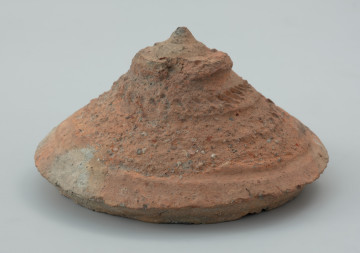
Clay lid
951 — 1200
National Museum in Szczecin
Part of the collection: Middle Ages
The pot from Cedynia, which dates back to the 9th-10th centuries, is characterised by its biconical shape and a very short neck, which smoothly transitions into the body, located in the lower third of the vessel. The vessel was made by sticking clay rolls of pottery mass to the bottom. Only the upper part of the vessel bears traces of being turned on the potter's wheel. Vessels made entirely without the use of a potter's wheel were very rarely decorated with single wavy lines. The surface of partially turned, biconical vessels, was usually adorned with carved wavy and diagonal lines, without much attention to detail. On the other hand, the bulbous and gently profiled vessels were often decorated with braids, vertical and horizontal lines of diagonal punctures, straight and zig-zagging lines, and in rare cases with stamp impressions. A typical feature characteristic of partially turned vessels involved ornamentation only in the upper part. The surface of the neck of the vessel from Cedynia bears diagonally crossed engraved lines delimited from the top and bottom by engraved lines running around the pot.
Grzegorz Durdyń
Author / creator
Dimensions
cały obiekt: height: 21.4 cm
Object type
culinary equipment, vessel (container)
Technique
upper part rolling, roller technique, manual modelling, forming
Material
ceramic
Origin / acquisition method
field research
Creation time / dating
Creation / finding place
Owner
Muzeum Narodowe w Szczecinie
Identification number
Location / status

951 — 1200
National Museum in Szczecin

951 — 1250
National Museum in Szczecin

476 — 1250
National Museum in Szczecin
DISCOVER this TOPIC
Museum of King Jan III's Palace at Wilanów
DISCOVER this PATH
Educational path